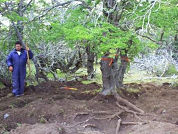Out of sight… What can be done in order to further include the belowground compartment in vegetation studies?
DOI:
https://doi.org/10.25260/EA.20.30.2.0.965Keywords:
roots, belowground biomass, below-ground net primary productivity, root traits, decomposition, Argentina, UruguayAbstract
To know the structure and functioning of the belowground vegetation compartment is essential to understand numerous processes that occur at different organization levels. However, the belowground vegetation compartment has traditionally been less studied than the above layer due to the great effort required for field sampling and laboratory processing. In the XXVIII Reunión Argentina de Ecología, Mar del Plata 2018, two symposia about the importance of root knowledge in ecological studies were conducted. From this exchange arose the need to 1) quantify studies that include data of belowground and aboveground vegetation, and 2) determine the methodologies and the variables of the belowground compartment recorded in natural (grasslands, steppes, forests, shrubs, and desert) and human modified systems (pastures, crops) in six Argentinean phytogeographic provinces and in two Uruguayan geomorphological regions. There were 933 published studies from 1990 to 2019. The 57% and 23% corresponded to exclusive studies of the above and belowground compartments respectively, with an exponential increase in the time of both fractions. Currently, there is a tendency to incorporate the underground compartment in ecological studies. Through systematic analysis, it was found that six sampling methods were used (soil core, ingrowth cores, trench, monoliths, rhizotron and belowground biomass estimation from aboveground biomass) where four variables of the belowground vegetation compartment were recorded (belowground biomass, belowground net primary productivity, root traits, and roots decomposition rate). Obtaining soil volumes by soil core was the most used method, while belowground biomass was the most evaluated variable. We propose to encourage collaboration between research teams and establish methodological comparisons to understand the scope of the results and obtain better estimates about the consequences of land-use change.
References
Bartos, D., and P. Sims. 1974. Dynamics of a shortgrass Ecosystem. J Range Manage 27:33-36. https://doi.org/10.2307/3896435.
Bucci, S. J., F. G. Scholz, G. Goldstein, F. C. Meinzer, and M. E. Arce. 2009. Soil water availability and rooting depth as determinants of hydraulic architecture of Patagonian woody species. Oecologia 160:631-641. https://doi.org/10.1007/s00442-009-1331-z.
Böhm, W. 1979. Methods of studying root systems. Springer-Verlag, Berlin, Germany. https://doi.org/10.1007/978-3-642-67282-8.
Dahlman, R., and C. Kucera. 1965. Root productivity and turnover in native prairie. Ecology 46:84-89. https://doi.org/10.2307/1935260.
Jackson, R. B., J. Canadell, J. R. Ehleringer, H. A. Mooney, O. E. Sala, and E. D. Schulze. 1996. A global analysis of root distributions for terrestrial biomes. Oecologia 108:389-411. https://doi.org/10.1007/BF00333714.
Lauenroth, W. 2000. Methods of estimating belowground net primary production. Pp. 58-71 in O. E. Sala, R. B. Jackson, H. A. Mooney and R. W. Howart (eds.). Methods in Ecosystem Science. Springer-V. New York, USA. https://doi.org/10.1007/978-1-4612-1224-9_5.
López-Mársico, L., A. Altesor, M. Oyarzabal, P. Baldassini, and J. Paruelo. 2015. Grazing increases below-ground biomass and net primary production in a temperate grassland. Plant Soil 392:155-162. https://doi.org/10.1007/s11104-015-2452-2.
Lund, Z., R. Pearson, and G. A. Buchanan. 1970. An implanted soil mass technique to study herbicide effects on root growth. Weed Science 18:279-281. https://doi.org/10.1017/S0043174500079753.
Mokany, K., R. Raison, and A. Prokushkin. 2006. Critical analysis of root:shoot ratios in terrestrial biomes. Global Change Biol 12:84-96. https://doi.org/10.1111/j.1365-2486.2005.001043.x.
Oyarzabal, M., J. Clavijo, L. Oakley, F. Biganzoli, P. Tognetti, I. Barberis, H. Maturo, R. Aragón, P. Campanello, D. Prado, M. Oesterheld, and R. J. León. 2018. Unidades de vegetación de la Argentina. Ecología Austral 28:40-63. https://doi.org/10.25260/EA.18.28.1.0.399.
Panario, D. 1988. Geomorfología del Uruguay. Facultad de Humanidades y Ciencias, Universidad de la República, Montevideo, Uruguay.
Pereyra, D. A., S. J. Bucci, N. S. Arias, N. Ciano, P. M. Cristiano, G. Goldstein, and F. G. Scholz. 2017. Grazing increases evapotranspiration without the cost of lowering soil water storages in arid ecosystems. Ecohydrology 10:1-12. https://doi.org/10.1002/eco.1850.
Poorter, H., J. Bühler, D. van Dusschoten, J. Climent, and J. Postma. 2012. Pot size matters: a meta-analysis of the effects of rooting volume on plant growth. Funct Plant Biol 39:839-850. https://doi.org/10.1071/FP12049.
Qi, Y., W. Wei, C. Chen, and L. Chen. 2019. Plant root-shoot biomass allocation over diverse biomes: A global synthesis. Global Ecol Conserv 18:e00606. https://doi.org/10.1016/j.gecco.2019.e00606.
Volante, J., J. Mosciaro, M. Morales Poclava, L. Vale, S. Castrillo, J. Sawchik, G. Tiscornia, M. Fuente, I. Maldonado, A. Vega, R. Trujillo, L. Cortéz, and J. Paruelo. 2015. Expansión agrícola en Argentina, Bolivia, Paraguay, Uruguay y Chile entre 2000-2010. Caracterización espacial mediante series temporales de índices de vegetación. Revista de investigaciones agropecuarias 41:179-191.
Smit, A., A. Bengough, C. Engels, M. van Noordwijk, S. Pellerin, and S. van de Geijn. 2000. Root methods: a handbook. Springer-Verlag, Berlin, Germany. https://doi.org/10.1007/978-3-662-04188-8.
Soriano, A., A. Golluscio, and E. Satorre. 1987. Spatial heterogeneity of the root system of grasses in the Patagonian arid Steppe. B Torrey Bot Club 114:103-108. https://doi.org/10.2307/2996118.
Upchurch, D., and J. Ritchie. 1983. Root observation using video recording system in mini-rhizotrons. Agronomy Journal 75:1009-1015. https://doi.org/10.2134/agronj1983.00021962007500060033x.
Weaver, J. 1915. A study of the root-systems of prairie plants of Southeastern Washington. The Plant World 18:227-248.
Wilson, S. 2014. Below-ground opportunities in vegetation science. J Veg Sci 25:1117-1125. https://doi.org/10.1111/jvs.12168.

Downloads
Published
How to Cite
Issue
Section
License
Copyright (c) 2020 Luis López Mársico, Sofía Pestoni, Georgina Conti, Natalia Pérez-Harguindeguy, Guillermo Martínez Pastur, Priscila Pinto, Agustín Sarquis, M. Fernanda Reyes, Pablo L. Peri, Gervasio Piñeiro

This work is licensed under a Creative Commons Attribution 3.0 Unported License.
Authors retain their rights as follows: 1) by granting the journal the right to its first publication, and 2) by registering the published article with a Creative Commons Attribution License (CC-BY 4.0), which allows authors and third parties to view and use it as long as they clearly mention its origin (citation or reference, including authorship and first publication in this journal). Authors can make other non-exclusive distribution agreements as long as they clearly indicate their origin and are encouraged to widely share and disseminate the published version of their work.


